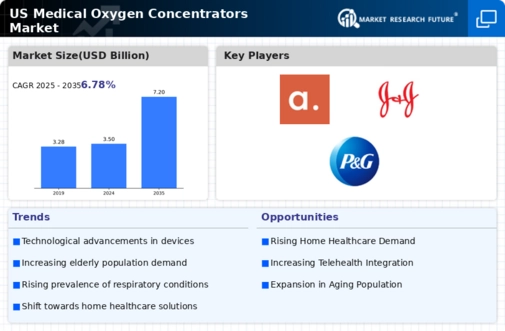Supportive Government Policies and Funding
Supportive government policies and funding initiatives are driving the growth of the medical oxygen-concentrators market. The US government has implemented various programs aimed at improving access to healthcare, particularly for individuals with chronic illnesses. These initiatives often include financial assistance for purchasing medical equipment, including oxygen concentrators. Additionally, reimbursement policies for oxygen therapy are becoming more favorable, encouraging patients to invest in these devices. As a result, the medical oxygen-concentrators market is likely to benefit from increased accessibility and affordability, which may lead to a rise in the number of patients utilizing oxygen therapy.
Rising Awareness of Oxygen Therapy Benefits
The medical oxygen-concentrators market is experiencing growth due to increasing awareness of the benefits of oxygen therapy among both healthcare professionals and patients. Educational initiatives and campaigns aimed at highlighting the importance of oxygen therapy in managing chronic respiratory conditions are gaining traction. This heightened awareness is leading to more patients seeking oxygen therapy as a viable treatment option. Furthermore, healthcare providers are becoming more proactive in recommending oxygen therapy, which is likely to boost the adoption of medical oxygen-concentrators. As the understanding of the therapeutic benefits of oxygen therapy expands, the market is expected to see a corresponding increase in demand for these devices.
Shift Towards Home-Based Healthcare Solutions
The medical oxygen-concentrators market is benefiting from a significant shift towards home-based healthcare solutions. Patients are increasingly opting for home care due to its convenience and cost-effectiveness. The US healthcare system is evolving, with a focus on reducing hospital readmissions and promoting outpatient care. This trend is reflected in the growing sales of portable oxygen concentrators, which allow patients to maintain their mobility while receiving necessary oxygen therapy. The market for these devices is projected to grow, with estimates suggesting a compound annual growth rate (CAGR) of around 8% over the next few years. As more patients seek to manage their health conditions at home, the demand for medical oxygen-concentrators is expected to rise significantly.
Increasing Prevalence of Respiratory Disorders
The medical oxygen-concentrators market is experiencing growth due to the increasing incidence of respiratory disorders such as chronic obstructive pulmonary disease (COPD) and asthma. According to the Centers for Disease Control and Prevention (CDC), approximately 16 million Americans are diagnosed with COPD, which necessitates the use of supplemental oxygen. This trend indicates a growing need for medical oxygen-concentrators, as they provide a reliable source of oxygen therapy for patients. Furthermore, the aging population in the US, which is more susceptible to respiratory ailments, is likely to contribute to the demand for these devices. As healthcare providers increasingly recognize the importance of oxygen therapy in managing chronic respiratory conditions, the medical oxygen-concentrators market is poised for significant expansion.
Technological Innovations in Oxygen Concentrators
Technological innovations are playing a crucial role in shaping the medical oxygen-concentrators market. Manufacturers are increasingly investing in research and development to enhance the efficiency and portability of oxygen concentrators. Recent advancements include the development of lightweight, battery-operated models that provide patients with greater freedom and flexibility. Additionally, features such as smart connectivity and user-friendly interfaces are becoming more prevalent, making it easier for patients to monitor their oxygen levels. The introduction of these advanced devices is likely to attract a broader consumer base, thereby driving market growth. As technology continues to evolve, the medical oxygen-concentrators market is expected to witness a surge in demand for innovative solutions.














Leave a Comment